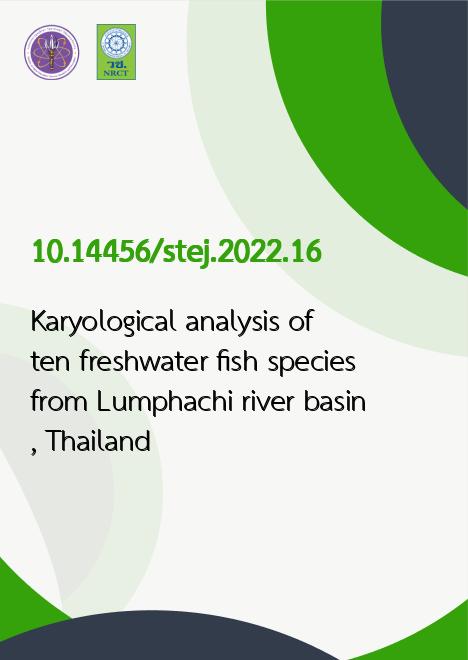
|
Karyological analysis of ten freshwater fish species from Lumphachi river basin, Thailand |
|---|---|
| รหัสดีโอไอ | |
| Creator | Nuntaporn Getlekha |
| Title | Karyological analysis of ten freshwater fish species from Lumphachi river basin, Thailand |
| Contributor | Pinij Sukchot, Kanchana Saleetid |
| Publisher | Mahasarakham University |
| Publication Year | 2565 |
| Journal Title | Science Technology and Engineering Journal (STEJ) |
| Journal Vol. | 8 |
| Journal No. | 2 |
| Page no. | 76-85 |
| Keyword | Freshwater fishes, chromosome, karyotype |
| URL Website | https://ph02.tci-thaijo.org/index.php/stej |
| Website title | Science Technology and Engineering Journal (STEJ) |
| ISSN | ISSN : 2697-6110 , 2697-6072 |
| Abstract | This research aims to study karyotype of ten species of freshwater fishes from Lumphachi river basin, Suan Phueng district, Ratchaburi province. Chromosomes were prepared directly from kidney tissue of each fish species (ten individual/species) and were then stained by conventional staining technique (Giemsa's stain). The karyotype results of all ten fish species were shown as followed: Clown featherback (Chitala ornata) (2n = 42; NF = 44; 2a+40t), Striped tiger leaffish (Pristolepis fasciatus) (2n = 48; NF = 48; 48t), Three spot gourami (Trichopodus trichopterus) (2n = 46; NF = 46; 46t), Silver barb (Barbonymus gonionotus) (2n = 50; NF = 78; 6m+16sm+6a+22t), Red tailed tinfoil (Barbonymus altus) (2n = 50; NF = 86; 12m+20sm+4a+14t), Tire track eel (Mastacembelus favus) (2n = 48; NF = 68; 10m+6sm+4a+28t), Black sharkminnow (Labeo chrysophekadion) (2n = 50; NF = 86; 10m+8sm+18a+14t), Poropuntius melanogrammus (2n = 50; NF = 86; 10m+12sm+14a+14t), Hampala barb (Hampala macrolepidota) (2n = 50; NF = 86; 6m+18sm+12a+14t), and Roho labeo (Labeo rohita) (2n = 50; NF = 80; 8m+14sm+8a+20t), respectively. No sex chromosome differences were found in all fish karyotypes. Based on the data, this is the first report of cytogenetic study of fish species in this area. The information obtained can be used to support the taxonomic classification of freshwater fishes, manipulated for conservation of genetic resources of fishes in nature, and can be useful to understanding of chromosomal evolution of freshwater fishes in the future. Moreover, this finding can be used as a basis for genetic resources conservation and chromosomal evolution among fishes in the future. |
